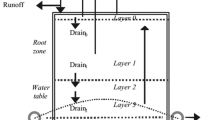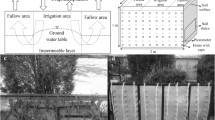Abstract
All of steady and non-steady subsurface drainage equations were developed mostly based on water flow pattern in an ordinary field conditions. However, subsurface drainage in a paddy field is quite different from subsurface drainage in an ordinary field. Thus, it is necessary to develop new equations and mathematical models to design subsurface drainage system in a paddy field. The objective of this study was to apply the HYDRUS-2D model, based on the Richard’s equation, to simulate water flow under subsurface drainage in a paddy field for various drain depths (0.5, 0.75 and 1.0 m) and spacings (7.5 and 15.0 m), surface soil textures (clay loam and silty clay loam) and crack conditions. Simulation results were compared with two well-known drainage equations. The maximum drainage rate was obtained under 7.5-m spacings and 1-m depth. With increasing drain spacings, the drainage rate decreased. Drain spacings had more effect on drainage rate and water pressure head as compared to drain depth. Drainage rates calculated by the Hooghoudt’s and Murashima and Ogino’s equations were much lower than those calculated by the Richard’s equation. The Hooghoudt’s equation, developed for ordinary fields, did not perform well for paddy fields. This study also proved the importance of cracks in subsurface drainage system of paddy fields. HYDRUS-2D stands as a robust tool for designing subsurface drainage in a paddy field.







Similar content being viewed by others
References
Boivin A, Šimůnek J, Schiavon M, van Genuchten MT (2006) Comparison of pesticide transport processes in three tile-drained field soils using HYDRUS-2D. Vadose Zone J 5(3):838–849
Crevoisier D, Popova Z, Mailhol JC, Ruelle P (2008) Assessment and simulation of water and nitrogen transfer under furrow irrigation. Agric Water Manag 95(4):354–366
Darzi-Naftchally A, Mirlatifi SM, Asgari A (2013) Comparison of steady-and unsteady-state drainage equations for determination of subsurface drain spacing in paddy fields: a case study in Northern Iran. Paddy Water Environ 12:1–9
Ebrahimian H, Parsinejad M, Liaghat A, Akram M (2011) Field research on the performance of a rice husk envelope in a subsurface drainage system (case study Behshahr, Iran). Irrig Drain 60(2):216–228
Ebrahimian H, Liaghat A, Parsinejad M, Playán E, Abbasi F, Navabian M (2013) Simulation of 1D surface and 2D subsurface water flow and nitrate transport in alternate and conventional furrow fertigation. Irrig Sci 31(3):310–316
Hooghoudt SB (1940) General consideration of the problem of field drainage by parallel drains, ditches, watercourses, and channels. Publication No.7 in the series contribution to the knowledge of some physical parameters of the soil. Bodemkundig Instituut, Groningen
Kroes JG, Van Dam JC (2003) Reference Manual SWAP version 3.0.3. Wageningen, Alterra, Green World Research. Alterra-report 773
Monjezi MS, Ebrahimian H, Liaghat A, Moradi MA (2013) Soil wetting front in surface and subsurface drip irrigation for silty loam soil. ICE Water Manag 166(5):272–284
Mualem Y (1976) A new model for predicting the hydraulic conductivity of unsaturated porous media. Water Resour Res 12(3):513–522
Murashima K, Ogino Y (1985) Design of pipe drainage using the modification coefficient (a). Trans Jpn Soc Irrig Drain Reclam Eng 119:13–20
Murashima K, Ogino Y (1992) Comparative study on steady and non-steady state formulae of subsurface drain spacing—design on subsurface drainage of paddies (1). Bull Univ Osaka Prefect Ser B 44:41–48
Ogino Y, Ota S (2007) The evolution of Japan’s rice field drainage and development of technology. Irrig Drain 56(1):69–80
Phogat V, Yadav AK, Malik RS, Kumar S, Cox J (2010) Simulation of salt and water movement and estimation of water productivity of rice crop irrigated with saline water. Paddy Water Environ 8(4):333–346
Provenzano G (2007) Using HYDRUS-2D simulation model to evaluate wetted soil volume in subsurface drip irrigation systems. Irrig drain Eng 133(4):342–349
Šimůnek J, Sejna M, van Genuchten MT (1999) The HYDRUS-2D software package for simulating the two dimensional movement of water, heat, and multiple solutes in variably saturated media Version 2.0, IGWMC-TPS-700. International Ground Water Modeling Center, Colorado School of Mines, Golden
Skaggs RW (1980) Drainmod reference report, methods for design and evaluation of drainage water management systems for soils with high water tables. USDA, SCS, North Carolina State University, Raliegh, p 185
Smedema LK, Vlotman WF, Rycroft D (2004) Modern land drainage: planning, design and management of agricultural drainage systems. Taylor & Francis, The Netherlands, p 449
Tabuchi T (2004) Improvement of paddy field drainage for mechanization. Paddy Water Environ 2(1):5–10
van Genuchten MT (1980) A closed form equation for predicting the hydraulic conductivity of unsaturated soils. Soil Sci Soc Am J 44:892–898
Conflict of interest
The authors declare that they have no conflict of interest.
Author information
Authors and Affiliations
Corresponding author
Rights and permissions
About this article
Cite this article
Ebrahimian, H., Noory, H. Modeling paddy field subsurface drainage using HYDRUS-2D. Paddy Water Environ 13, 477–485 (2015). https://doi.org/10.1007/s10333-014-0465-8
Received:
Revised:
Accepted:
Published:
Issue Date:
DOI: https://doi.org/10.1007/s10333-014-0465-8




